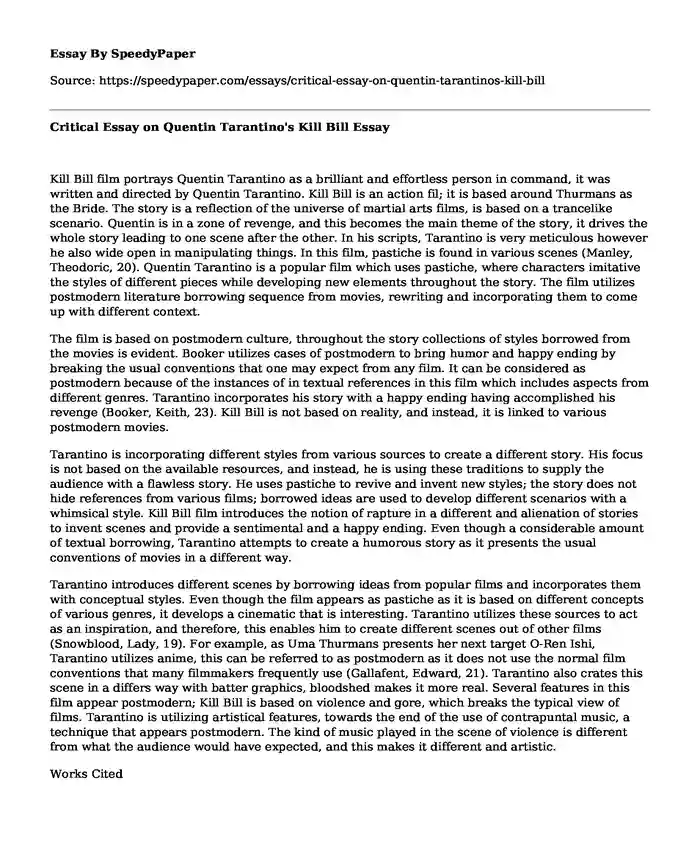Kill Bill film portrays Quentin Tarantino as a brilliant and effortless person in command, it was written and directed by Quentin Tarantino. Kill Bill is an action fil; it is based around Thurmans as the Bride. The story is a reflection of the universe of martial arts films, is based on a trancelike scenario. Quentin is in a zone of revenge, and this becomes the main theme of the story, it drives the whole story leading to one scene after the other. In his scripts, Tarantino is very meticulous however he also wide open in manipulating things. In this film, pastiche is found in various scenes (Manley, Theodoric, 20). Quentin Tarantino is a popular film which uses pastiche, where characters imitative the styles of different pieces while developing new elements throughout the story. The film utilizes postmodern literature borrowing sequence from movies, rewriting and incorporating them to come up with different context.
The film is based on postmodern culture, throughout the story collections of styles borrowed from the movies is evident. Booker utilizes cases of postmodern to bring humor and happy ending by breaking the usual conventions that one may expect from any film. It can be considered as postmodern because of the instances of in textual references in this film which includes aspects from different genres. Tarantino incorporates his story with a happy ending having accomplished his revenge (Booker, Keith, 23). Kill Bill is not based on reality, and instead, it is linked to various postmodern movies.
Tarantino is incorporating different styles from various sources to create a different story. His focus is not based on the available resources, and instead, he is using these traditions to supply the audience with a flawless story. He uses pastiche to revive and invent new styles; the story does not hide references from various films; borrowed ideas are used to develop different scenarios with a whimsical style. Kill Bill film introduces the notion of rapture in a different and alienation of stories to invent scenes and provide a sentimental and a happy ending. Even though a considerable amount of textual borrowing, Tarantino attempts to create a humorous story as it presents the usual conventions of movies in a different way.
Tarantino introduces different scenes by borrowing ideas from popular films and incorporates them with conceptual styles. Even though the film appears as pastiche as it is based on different concepts of various genres, it develops a cinematic that is interesting. Tarantino utilizes these sources to act as an inspiration, and therefore, this enables him to create different scenes out of other films (Snowblood, Lady, 19). For example, as Uma Thurmans presents her next target O-Ren Ishi, Tarantino utilizes anime, this can be referred to as postmodern as it does not use the normal film conventions that many filmmakers frequently use (Gallafent, Edward, 21). Tarantino also crates this scene in a differs way with batter graphics, bloodshed makes it more real. Several features in this film appear postmodern; Kill Bill is based on violence and gore, which breaks the typical view of films. Tarantino is utilizing artistical features, towards the end of the use of contrapuntal music, a technique that appears postmodern. The kind of music played in the scene of violence is different from what the audience would have expected, and this makes it different and artistic.
Works Cited
Booker, M. Keith. Postmodern Hollywood: what's new in film and why it makes us feel so strange. Greenwood Publishing Group, 2007.
Gallafent, Edward. Quentin Tarantino. Routledge, 2014.
Manley, Theodoric. "Race on the QT: Blackness and the films of Quentin Tarantino." (2016): 1519-1521.
Snowblood, Lady. "Shurayukihime." Dir. Toshiya Fujita. Toho (1973).
Cite this page
Critical Essay on Quentin Tarantino's Kill Bill. (2023, Jan 29). Retrieved from https://speedypaper.net/essays/critical-essay-on-quentin-tarantinos-kill-bill
Request Removal
If you are the original author of this essay and no longer wish to have it published on the SpeedyPaper website, please click below to request its removal:
- Incivility in Nursing - Free Essay
- Free Essay on Ideal Relationship Between Boss and Employee
- Free Essay on Academic and Career Goals: Computer Information Systems
- Business and Finance Essay Example
- Definition Essay Example: Structuralism, Functionalism, and Psychodynamic
- Essay Sample: Aviation Leadership with a Christian Perspective
- Theory of Integral Nursing and Practice, Free Essay Example
Popular categories





